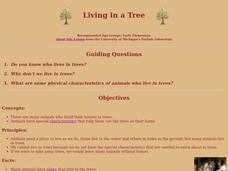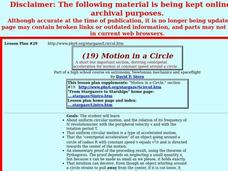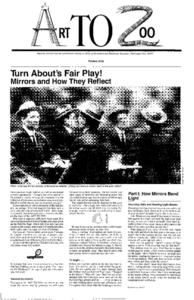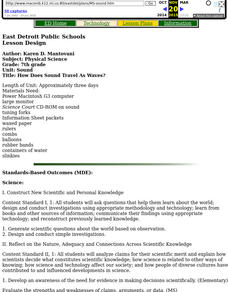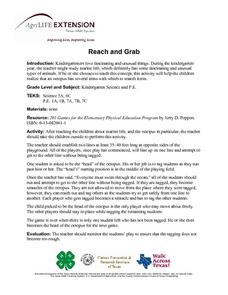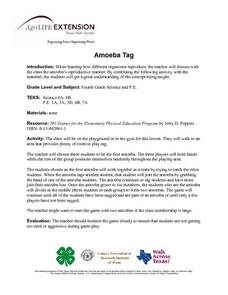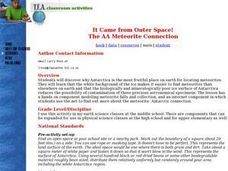Curated OER
Seed Germination
Learners explore the process of seed germination. For this botany lesson, students complete an experiment with seeds. Learners observe soaked and dry seeds. Students allow the seeds to germinate and make observations during this time....
Curated OER
Living in a Tree
Students explore animals that live in trees. In this nature and biology lesson, students go outdoors and make observations about animals and their unique body parts that help them to live in trees. Students create drawings as they...
Curated OER
Measuring Calories in Food
Students measure the amount of calories in food. In this food energy lesson, students discuss what a calorie is, how our bodies use a calorie, and how many we need. Then, students use a calorimeter to calculate the amount of energy in a...
Curated OER
The Dance of the Butterfly
Learners explore butterfly life cycles and movement. In this integrated fine arts and biology life cycle lesson, students listen to the book The Very Hungry Caterpillar by Eric Carle and identify the related life cycle stages....
Curated OER
MOTION IN A CIRCLE
Young scholars explore uniform circular motion, and the relation of its frequency of N revolutions/sec with the peripheral velocity v and with the rotation period T, and the "centripetal acceleration" of an object.
Curated OER
The Greatest Show on Earth: The World's Smallest Animals
Students create instruments to capture different types of insects. In this The Greatest Show on Earth: The World's Smallest Animals lesson, students compare the attributes of certain insects and record the data on a chart. After catching...
Curated OER
Mirrors and How They Reflect
Students experiment with mirrors. In this Mirrors and How They reflect lesson, students read how mirrors reflect light. Then students perform over ten experiments and record their conclusions about mirrors and reflection. Students create...
Curated OER
Endangered Species - Can We Help Them Survive?
Learners, in groups, select an animal that has been identified as endangered and then identify its characteristics. They discuss why the animal has become endangered, evaluate adaptations for its survival and include an illustration.
Curated OER
Readings in Hudson River Natural History: Understanding Informational Text
After reading a series of informational articles regarding the Hudson River Estuary, the class will answer a series of comprehension questions. An answer key is provided but the articles and worksheets are not.
Curated OER
Solar System
Second graders create planet mobiles in order to reinforce concepts such as planet size, position in relation to the sun, and planet names.
Curated OER
How Does Sound Travel As Waves?
Seventh graders participate in a number of activities designed to increase their understanding of how sound is generated and how it travels.
Curated OER
What is electrical energy?
Students distinguish between items with and without energy. In this energy lesson, students understand that natural resources power electrical apparatus and that energy needs to be saved.
Curated OER
Reflecting Light
Students are introduced to the reflective properties of light and use mirrors to make light from a source reflect onto a specific target. They take turns and record the amount of time it took to correctly reflect the light.
Curated OER
Race the Track! Jump the Gap
Students record data of using a track system with variables and how those variables affect a ball used in the track. In this track lesson plan, students design their own track in groups, test the ball's rates of speed, and record their...
Curated OER
Magnify That
Learners observe many different objects using a magnifying lens. In this magnification lesson plan, students learn that scientists use different tools, and they use the tool to magnify objects in the classroom to see objects in better...
Curated OER
Root, Root, Root for the Nutrients
Students observe the growth of a seed, predict what will happen when seeds are planted without soil, and conduct an experiment using a hydroponics system.
Curated OER
Hearts in Motion
Young scholars participate in cardiovascular activities. In this physical education lesson, students are divided into groups and brainstorm activities to get their heart rate up. Young scholars demonstrate the activity for classmates.
Curated OER
Reach and Grab
Students examine the different types of marine life and participate in an activity to show the many arms of an octopus.
Curated OER
Rock, Soil, or Water?
Pupils participate in an activity in which they identify properties of water, soil and rocks. They work together to identify different types of rocks. They ask questions to complete the instructional activity.
Curated OER
Amoeba Tag
Fourth graders investigate how different organisms reproduce by participating in a Amoeba Tag game. Students work as a team and try to catch each other -- thus "reproducing" amoebas.
Curated OER
It Came from Outer Space! The AA Meteorite Connection
Students discover why Antarctica is the most fruitful place on earth for locating meteorites. They work in groups. Students are given a Museum or University Name for each group. They are explained that each group is allowed to comb...
Curated OER
The Wind and Its Origin
Students discuss the wind and how it feels. Using talcum powder and a lamp, students participate in an activity where they observe spirals in the air. They discover the causes of wind and how hot air rises and cold air sinks.
Curated OER
Air...What Gives?
Students investigate the properties of air by capturing it, squeezing it, and feeling its weight. In this forces lesson, students capture bags of air and examine its properties. The weight and pressure of air is emphasized.
Curated OER
Air Takes Space
Students examine how air takes space. They come up, push a deflated balloon into one of the bottles and stretch the open end of the balloon over the bottles mouth

